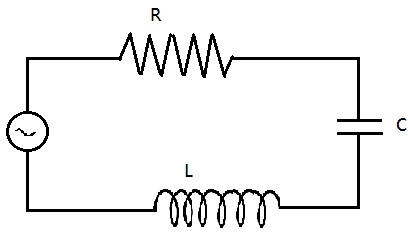Question
Question: The figure shows a series LCR circuit with \(L = 54H\) , \(C = 80\mu F\) , \(R = 40\Omega \) connect...
The figure shows a series LCR circuit with L=54H , C=80μF , R=40Ω connected to a variable frequency 240V source, calculate:
(A) The angular frequency of the source which drives the circuit at resonance,
(B) The current at the resonating frequency,
(C) The rms potential drops across the inductor at resonance.

Solution
Draw the circuit diagram for the given condition. The angular frequency is inversely proportional to the product of square root of Inductance and capacitance. At resonating frequency, we have ωL=ωC1 hence now impedance can be calculated and hence the current can also be calculated.
Complete step by step solution:
Let’s draw the circuit first with the values of resistance, conductance and inductance.

The above image shows a LCR series circuit.
(A) The angular frequency is also known as resonance frequency and is depicted as ωr , the angular frequency is given as:
ωr=LC1
Substituting the values of inductance and capacitance from the given question, we have:
⇒ωr=54∗80∗10−61
⇒ωr=15.2rad/s
Hence the angular frequency is ωr=15.2rad/s
(B) To calculate the current in LCR circuit at resonance we must understand that at resonant frequency the magnitude of inductance and capacitance is equal and hence the only impedance is due to the resistance. Taking this into account we can calculate the impedance as follows:
Z=R
Where Z is impedance and R is the resistance.
Now current is given as:
I=ZV
Where I is the current.
⇒I=RV since Z=R
Substituting the values, we have
⇒I=40240
I=6A
Therefore, the value of current at resonating frequency is I=6A
(C) The peak voltage will be given as:
V0=2V
Where V0 indicates the peak voltage.
Similarly the peak current will be I0=Z2V where I0 is the peak current
⇒I0=402(240)
⇒I0=8.49A
Hence at resonance the impedance of the circuit is 40Ω and the amplitude of the current is I0=8.49A.
The rms potential drop across the inductor:
VL(rms)=IωrL
Where VL(rms) is the potential drop at rms across inductance;
ωr is the angular frequency or resonance frequency
Therefore, potential drop is
VL(rms)=6∗15.2∗54
⇒4934.2V
Note: It is to be noted that the potential drop across the capacitance is also 4934.2V hence the potentials of capacitance and inductance are equal. The potential drop across the capacitance can be calculated as I(ωC1). Be careful while substituting the values and avoid making calculation errors. While solving the question do remember that the value of capacitance is in microfarads.
